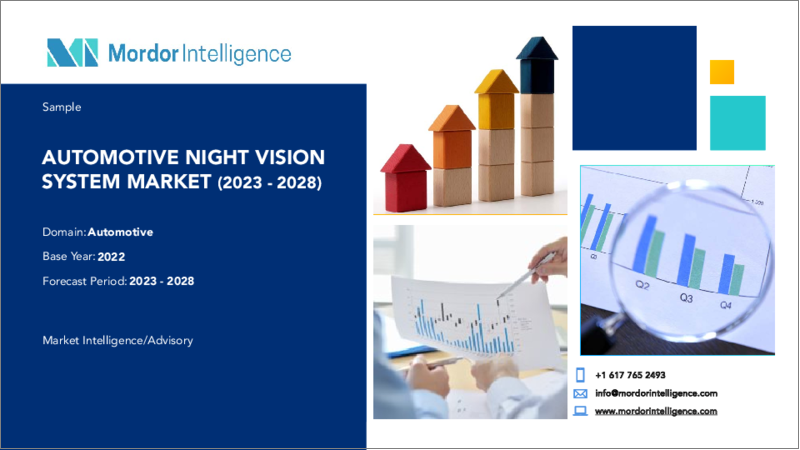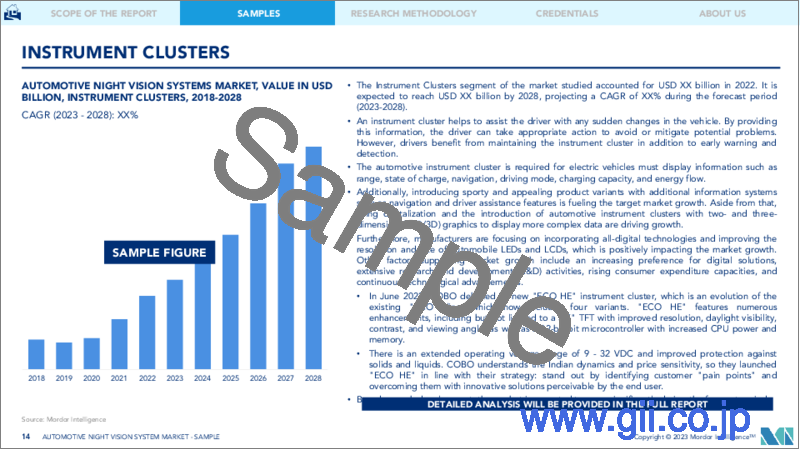|
|
市場調査レポート
商品コード
1189958
自動車用ナイトビジョンシステム市場- 成長、動向、予測(2023年~2028年)Automotive Night Vision System Market - Growth, Trends, and Forecasts (2023 - 2028) |
||||||
|
● お客様のご希望に応じて、既存データの加工や未掲載情報(例:国別セグメント)の追加などの対応が可能です。 詳細はお問い合わせください。 |
|||||||
| 自動車用ナイトビジョンシステム市場- 成長、動向、予測(2023年~2028年) |
|
出版日: 2023年01月18日
発行: Mordor Intelligence
ページ情報: 英文 100 Pages
納期: 2~3営業日
|
- 全表示
- 概要
- 目次
自動車用ナイトビジョンシステム市場は、2021年に33億3000万米ドル、2027年には62億3000万米ドルに成長し、予測期間中(2022~2027年)に11%強のCAGRで推移すると予測されています。
COVID-19の大流行が市場にマイナスの影響を与えました。2020年に報告された低車両販売台数により、ナイトビジョンシステムの大きな市場ポテンシャルは浅いものとなっています。また、車両の移動が著しく少ないか、ほぼゼロであったため、業界のアフターマーケット部門は多くの売上を記録することはありません。しかし、乗用車の販売増が見込まれ、乗用車・商用車ともに安全に対する意識が高まっていることから、市場は復活し、共産化以前の状態にまで経済成長することが期待されています。
中期的には、交通安全に対する社会的意識の高まり、高級車の販売増、政府・安全機関の厳しい規制強化による自動車メーカーによる事故防止技術の開発志向などが、市場の需要を支えていくと思われます。
ナイトビジョンシステム(NVS)は現在、高級車のみに搭載されていますが、2023年末には大衆向け中型車セグメントでも利用できるようになると予想されます。しかし、センサーやディスプレイユニットなど、システムに使用されている技術が高価であるため、ナイトビジョンシステムの価格が高いことが大きな脅威となっています。
自動車用ナイトビジョンシステム市場は欧州が最大中国市場が伸び悩んでいるにもかかわらず、世界最大の自動車市場。一方、アジア太平洋地域は、中国、インド、日本を含むAPAC諸国における自動車および自動車部品メーカーの急増に起因して、大幅な成長が見込まれています。
主な市場動向
予測期間中に大幅な成長が見込まれる遠赤外線セグメント
ナイトビジョンセンサーシステムは、自動車に搭載されることが多くなっています。遠赤外線(FIR)画像から自動車を検出するために、赤外線センサーを使用したさまざまな方法が文献で提案されています。しかし、これらの方式はまだ車両検知率が低く、性能向上が望まれています。赤外線を用いたカメラからの画像は、低照度下での促進要因の知覚を向上させることが期待されます。しかし、このシステムの最大の欠点は、促進要因が道路交通から注意をそらさないよう、適切なタイミングで画像を表示することができないことです。
現在、多くの交通事故は夜間など視界の悪い時間帯に発生しています。しかし、既存の自動車用アルゴリズムや検知システムのほとんどは、可視スペクトルカメラによる昼間の車両検知に焦点を当てたものです。夜間の車両検知や車両ランプの検知については研究が進められています。それでも、これらの検出は一般的に、雨、低照度、カメラの露出時間など、さまざまな要因に影響されます。
- 2021年5月、フリアーシステムズは、欧州初の赤外線画像地域データセットとマシンビジョンテスト用赤外線画像データセットシリーズの第3弾の提供を発表しました。研究者、開発者、自動車メーカーが安全、先進運転支援システム(ADAS)、自動緊急ブレーキ(AEB)、自律走行車(AV)システムの研究を強化、加速するために設計されたこのデータセットは、欧州6都市で撮影した日中、夜間、各種天候時の注釈付き熱画像数千枚が収録されています。
- 2021年4月、韓国のハンファシステムズは、自律走行車用暗視カメラ開発のコンソーシアムに参加することを発表しました。このコンソーシアムは、韓国の電装品サプライヤーであるerae AMSが主導しています。昼光と赤外線を組み合わせた3Dフュージョンカメラを2025年までに開発することを目指しています。
アジア太平洋地域が予測期間中に大幅な成長を遂げると予想される
アジア太平洋地域が市場を独占し、今後数年間も同じ傾向が続くと予想され、次いで欧州、北米の順となっています。中国は、自動車の販売や生産など、あらゆる面で自動車業界をリードしています。高級車に対する需要の高まりは、ナイトビジョンシステム市場に大きく寄与しています。
- 中国の電気自動車市場は急速に拡大しており、世界の電気自動車市場シェアの半分以上を中国が占めています。2021年には、中国で約290万台のバッテリー式電気自動車が販売され、2020年と比較して162%増加する見込みです。同年(2021年)の中国でのプラグインハイブリッド車の販売台数は約60万3,000台で、前年(2020年)比140%増となりました。
また、電気自動車市場とともに、ナイトビジョンシステムなど、電気自動車のADAS機能の充実を求める声も高まっています。市場で事業を展開する複数の主要企業は、この点に関する戦略を立案しています。また、同市場では、高度なナイトビジョンシステムを搭載した最新モデルの発売が相次いでいます。例えば、次のようなものです。
- 2021年4月、韓国のハンファシステムズ(Hanwha Systems)は、自律走行車用のナイトビジョンカメラを開発するコンソーシアムに参加すると発表しました。このコンソーシアムには、韓国の電気部品メーカーであるerea AMSが参加しています。昼光と赤外線を組み合わせた3Dフュージョンカメラを2025年までに作ることを目指しています。ハンファシステムズは、2020年に発表したインテリジェント赤外線画像エンジンモジュール技術「Quantum Red」を応用し、XGAクラス(1024×768ピクセル)のナイトビジョンシステムを開発する予定です。
- 2020年12月、東風汽車有限公司(東風汽車)のVOYAHブランドは、中大型インテリジェント電気SUV「VOYAH FREE」を深センで公開しました。同車に採用されたアクティブナイトビジョンシステムは、150メートルの遠方視認とAI認識警告に対応します。
その他の特典。
- エクセル形式の市場予測(ME)シート
- アナリストによる3ヶ月間のサポート
目次
第1章 イントロダクション
- 調査の前提条件
- 調査範囲
第2章 調査手法
第3章 エグゼクティブサマリー
第4章 市場力学
- 市場促進要因
- 市場抑制要因
- 産業の魅力- ポーターのファイブフォース分析
- 新規参入業者の脅威
- 買い手/消費者の交渉力
- 供給企業の交渉力
- 代替品の脅威
- 競争企業間の敵対関係
第5章 市場セグメンテーション(市場規模:10億米ドル)
- 技術タイプ
- 遠赤外線(FIR)
- 近赤外線(NIR)
- ディスプレイタイプ
- ナビゲーションシステム
- インストルメントクラスター
- HUD
- コンポーネントタイプ
- ナイトビジョンカメラ
- 制御ユニット
- 表示部
- センサー
- その他の部品
- 地域別
- 北米
- 米国
- カナダ
- その他北米地域
- 欧州
- ドイツ
- 英国
- フランス
- イタリア
- スペイン
- その他の欧州地域
- アジア太平洋地域
- 中国
- 日本
- インド
- 韓国
- その他アジア太平洋地域
- 世界のその他の地域
- 南米
- 中東・アフリカ
- 北米
第6章 競合情勢
- ベンダーの市場シェア
- 企業プロファイル
- Robert Bosch GmbH
- DENSO Corporation
- Audi AG
- Daimler AG
- Autoliv Inc.
- Visteon Corporation
- Magna International Inc.
- L3 Technologies Inc.
- Raytheon Company
- Aisin Seiki Co Ltd
- Delphi Automotive PLC
- Valeo SA
- Hella KGaA Hueck & Co.
- FLIR Systems Inc.
第7章 市場機会と今後の動向
The Automotive night vision system market was valued at USD 3.33 Billion in 2021 and is expected to grow to USD 6.23 Billion by 2027, registering a CAGR of over 11% during the forecast period (2022-2027).
The Covid-19 pandemic had a negative impact on the market. With low vehicle sales reported In 2020, the significant market potential for night vision systems was shallow. Also, with significantly less or almost zero vehicular movements, the aftermarket sector of the industry did not register many sales. However, with the expected increase in sales of passenger vehicles and increased awareness of safety in both passenger and commercial vehicles, the market is looking forward to reviving and growing economically back to pre-covid conditions.
Over the medium-term growing public awareness of road safety, increased sales of luxury cars, and the inclination of automobile manufacturers to develop more advanced technologies to prevent accidents (due to the enactment of stringent regulations by governments and safety organizations) are likely to support demand in the market.
Though night vision systems (NVSs) are currently available only for luxury cars, they are expected to be available in the mass mid-car segments by the end of 2023. However, the high prices of night vision systems pose a significant threat, as the technologies used in systems, like sensors and display units, are expensive.
Europe is the largest Automotive Night Vision System Market Despite the Chinese market experiencing sluggish growth, the world's largest automobile market. On the other hand, Asia-Pacific is expected to grow significantly attributed to the proliferation of automotive & automotive component manufacturers in APAC countries, including China, India, and Japan.
Key Market Trends
Far Infrared Segment Expected to Grow Significantly During the Forecast Period
Night vision sensor systems are becoming more common in vehicles. Different methods using infrared sensors are suggested in the literature to detect cars in far-infrared (FIR) images. However, these systems still have low vehicle detection rates, and their performances may be enhanced. Images from cameras with infrared are expected to improve the driver's perception under low-light conditions. The main drawback of this system is that it cannot display the images at the right time to avoid distracting the driver from road traffic.
Currently, many road accidents occur during times of low visibility, such as at night. However, most existing automobile algorithms and detection systems are focused on daylight vehicle detection with visible spectrum cameras. Studies are going on regarding night-time vehicle and vehicle lamp detection. Still, these detections are generally affected by different factors, like rain, low illumination, and camera exposure time.
- In May 2021, FLIR Systems announced the availability of its first European thermal imaging regional dataset and the third in a series of thermal imaging datasets for machine vision testing. Designed to help researchers, developers, and auto manufacturers enhance and accelerate work on safety, advanced driver assistance systems (ADAS), automatic emergency braking (AEB), an autonomous vehicle (AV) systems, the dataset features thousands of annotated thermal images of daytime, night-time and various weather scenarios from six cities across Europe.
- In April 2021, South Korea's Hanwha Systems Co., Ltd. announced that it would participate in a consortium for developing night vision cameras for autonomous driving vehicles. The consortium is led by erae AMS Co., Ltd., a South Korean electrical component supplier. It aims to develop 3D fusion cameras by 2025 by combining daylight and thermal imaging.
Asia-Pacific Region Anticipated to Grow at Significant Level During the Forecast Period
Asia-Pacific dominated the market and is expected to witness the same trend in the coming years, followed by Europe and North America. China is the leader in the automotive industry in every aspect, whether it is the sales or production of vehicles. The country's growing demand for luxury vehicles contributes significantly to the night vision system market.
- The Chinese market for electric vehicles is swiftly growing, and China holds more than half of the electric vehicle market share globally. In 2021, around 2.9 million battery electric vehicles will be sold in China, an increase of 162 percent compared to 2020. In the same year(2021), about 603,000 plug-in hybrid cars were sold in China, an increase of 140 percent compared to the previous year (2020).
The demand for more ADAS functions in electric cars, such as night vision systems, is also growing with the electric car market. Several key players operating in the market are designing strategies in this regard. The market is also witnessing the launch of the latest models with advanced night vision systems. For instance,
- In April 2021, South Korea's Hanwha Systems Co., Ltd. (Hanwha Systems) announced that it would participate in a consortium for developing night vision cameras for autonomous driving vehicles. The consortium is led by erea AMS Co. Ltd, a South Korean electrical component supplier. It aims to create 3D fusion cameras by 2025 by combining daylight and thermal imaging. Hanwha Systems plans to apply its intelligent thermal imaging engine module technology, Quantum Red, released in 2020, to develop XGA-class (1024 x 768 pixels) night vision system.
- In December 2020, the VOYAH brand of Dongfeng Motor Corporation (Dongfeng Motor) revealed VOYAH FREE, a mid to large-sized intelligent electric SUV, in Shenzhen. The active night vision system used in the vehicle supports 150-meter distant vision and AI recognition warning.
Competitive Landscape
The market is highly consolidated by major players, like DENSO Corporation, Valeo, Autoliv Inc., Daimler AG, and Hella. DENSO Corporation has dominated the market. The key players are proactively focusing on new product developments & launches to gain a competitive advantage in the market.
- In January 2021, Volvo Cars announced that Night Vision, developed by Raytheon Commercial Infrared, will be available in the Volvo XC90 SUV, unveiled at the North American International Auto Show. The Volvo Night Vision system has a 50 percent wider field of view and a deployed combiner mirror head-up display (HUD) that folds flush to the dashboard when not in use.
- In August 2021, Daimler unveiled the 2021 Mercedes-Benz S-Class equipped with Night View Assist Plus, a night vision system that uses infrared technology with a unique camera to provide a clear outlook of the road while driving at dark. This system automatically focuses its headlights on nearby pedestrians and can detect cold objects too.
- In December 2019, Valeo unveiled its PictureBeam Monolithic technology; the first high-definition LED intelligent lighting solution to improve safety at night. This technology can project around 4,000 pixels onto the road from a single lighting module; PictureBeam Monolithic produces a far-reaching beam of light for an optimal field of vision and offers the best anti-glare function available to date.
Additional Benefits:
- The market estimate (ME) sheet in Excel format
- 3 months of analyst support
TABLE OF CONTENTS
1 INTRODUCTION
- 1.1 Study Assumptions
- 1.2 Scope of the Study
2 RESEARCH METHODOLOGY
3 EXECUTIVE SUMMARY
4 MARKET DYNAMICS
- 4.1 Market Drivers
- 4.2 Market Restraints
- 4.3 Industry Attractiveness - Porter's Five Forces Analysis
- 4.3.1 Threat of New Entrants
- 4.3.2 Bargaining Power of Buyers/Consumers
- 4.3.3 Bargaining Power of Suppliers
- 4.3.4 Threat of Substitute Products
- 4.3.5 Intensity of Competitive Rivalry
5 MARKET SEGMENTATION (Market Size in Value - USD billion)
- 5.1 Technology Type
- 5.1.1 Far Infrared (FIR)
- 5.1.2 Near Infrared (NIR)
- 5.2 Display Type
- 5.2.1 Navigation System
- 5.2.2 Instrument Cluster
- 5.2.3 HUD
- 5.3 Component Type
- 5.3.1 Night Vision Camera
- 5.3.2 Controlling Unit
- 5.3.3 Display Unit
- 5.3.4 Sensor
- 5.3.5 Other Components
- 5.4 Geography
- 5.4.1 North America
- 5.4.1.1 United States
- 5.4.1.2 Canada
- 5.4.1.3 Rest of North America
- 5.4.2 Europe
- 5.4.2.1 Germany
- 5.4.2.2 United Kingdom
- 5.4.2.3 France
- 5.4.2.4 Italy
- 5.4.2.5 Spain
- 5.4.2.6 Rest of Europe
- 5.4.3 Asia-Pacific
- 5.4.3.1 China
- 5.4.3.2 Japan
- 5.4.3.3 India
- 5.4.3.4 South Korea
- 5.4.3.5 Rest of Asia-Pacific
- 5.4.4 Rest of the World
- 5.4.4.1 South America
- 5.4.4.2 Middle-East and Africa
- 5.4.1 North America
6 COMPETITIVE LANDSCAPE
- 6.1 Vendor Market Share
- 6.2 Company Profiles*
- 6.2.1 Robert Bosch GmbH
- 6.2.2 DENSO Corporation
- 6.2.3 Audi AG
- 6.2.4 Daimler AG
- 6.2.5 Autoliv Inc.
- 6.2.6 Visteon Corporation
- 6.2.7 Magna International Inc.
- 6.2.8 L3 Technologies Inc.
- 6.2.9 Raytheon Company
- 6.2.10 Aisin Seiki Co Ltd
- 6.2.11 Delphi Automotive PLC
- 6.2.12 Valeo SA
- 6.2.13 Hella KGaA Hueck & Co.
- 6.2.14 FLIR Systems Inc.




